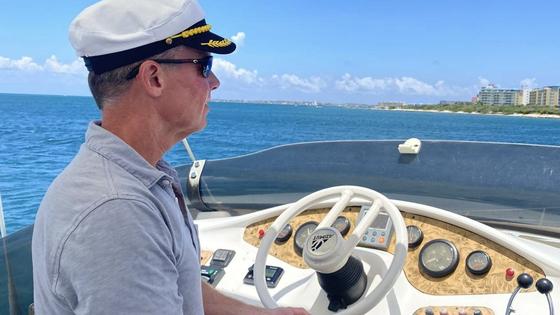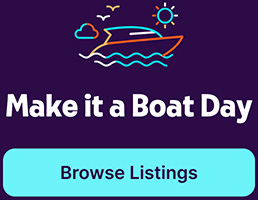For any boat owner who has seen increasing annual costs of ownership for things like dock fees, storage, maintenance, and insurance, the idea of renting out your boat or hosting captained charters can be an attractive one. What can start as a strategy to offset costs can turn into a side hustle, a retirement job, or a full-blown business.
You don’t need to sell your boat, with tools like Getmyboat, you can monetize it.
Now, there are important things to consider when you decide to rent out your boat. For the “no one drives my boat except me” crowd, a peer-to-peer bareboat rental is not an option. It’s okay to be attached to your vessel, but that doesn’t mean you can’t earn money with it. With a bit of education, certification, and experience, you can become a charter captain, earning money AND having an excuse to get out on the water more frequently.
For boat owners who are more open to renting their boat directly to customers, check out this guide we’ve created to get started. For our more hesitant owners who have played with the idea of getting their captain’s license in order to host charters — read on.
Step 1: Determine the Right Captain’s License for You
The U.S. Coast Guard (USCG) offers different Merchant Mariner Credentials (MMCs). The two most common for charter operators are:
- OUPV (Operator of Uninspected Passenger Vessels, also called the “6-Pack” License): Allows you to carry up to 6 paying passengers on an uninspected vessel. Most small boat charters use this.
- Master License (25, 50, or 100 Ton): Required if you plan to operate larger inspected vessels or carry more than 6 passengers.
👉 Decide which license fits your boat size and desired business model.
Step 2: Meet Eligibility Requirements
To qualify for a USCG Captain’s License, you’ll need:
- Age: Be at least 18 years old for OUPV and 19 years old for Master.
- Sea Service: Proof of boating experience. For OUPV, at least 360 days of sea time (with 90 in the last 3 years). This can be on your own boat or another vessel. If you haven’t been logging your time, start now! This can also give you some time to contemplate if a captain’s route is right for you.
- Citizenship/Residency: U.S. citizen or permanent resident.
- Physical Requirements: Pass a USCG physical exam and be medically fit.
- Drug Test: Negative result from a DOT-approved drug screening program.
- TWIC Card: Transportation Worker Identification Credential from the TSA (required for most licenses). You can apply online for this credential, and it will involve a background check.
Step 3: Complete Required Training
Enroll in a USCG-approved training school. Courses typically include:
- Navigation & Chart Plotting
- Rules of the Road (COLREGS)
- Deck General & Safety
- Environmental Responsibilities
- Emergency Procedures & First Aid/CPR
👉 Many schools offer both in-person and online options, with exams at the end that substitute for the USCG exam. Getmyboat also offers special discounts through our partnership with Mariners Learning System. All Getmyboat owners located in the United States can receive a 10% discount on USCG-certified courses offered online by using the code GETMYBOAT10.
Step 4: Submit Your Application to the USCG
- Collect your documents:
- Course completion certificate
- TWIC card
- Sea service forms (USCG Form CG-719S)
- Physical exam & drug test results
- Proof of citizenship
2. Fill out the CG-719B Application Form.
3. Pay applicable fees.
4. Submit the application through your Regional Exam Center (REC).
👉 Processing can take 4–8 weeks, depending on volume.
Step 5: Set Up Your Business Legally
Before you begin chartering, set up your business structure:
- Register your business (LLC, sole proprietorship, etc.) in your state.
- Get an EIN (Employer Identification Number) from the IRS for taxes.
- Obtain insurance: Commercial boat liability insurance is required for operating paid charters.
- Check local regulations: Some cities, counties, or marinas require additional permits for commercial charters.
Step 6: Ensure Your Boat is Charter-Ready
- Safety Equipment: Must meet USCG minimums (life jackets, fire extinguishers, flares, throwable devices, etc.).
- Regular Maintenance: Keep logs of service, inspections, and repairs.
- Passenger Comfort: Seating, shade, cooler/refreshments, and a clean deck improve reviews and bookings.
Step 7: Create a Professional Getmyboat Listing
- Sign up on Getmyboat. It’s free to create an account
- Create your boat profile: Add high-quality photos, detailed descriptions, and highlight what makes your boat unique.
- Set pricing: Choose hourly, half-day, or full-day rates. You can also enable instant booking.
- Add experiences: Guests love to build custom itineraries. If you’re able to offer fishing trips, sunset cruises, water sports, sightseeing, make sure to put it in the description.
- Verify your credentials: Upload your USCG Captain’s License and insurance.
- Optimize your listing:
- Use keywords travelers search for (“Miami yacht charter,” “Lake Tahoe fishing trip”)
- Highlight amenities and inclusions of your boat charters (cooler with ice, floating mat, etc)
- Respond quickly to inquiries for higher visibility in search results
- Use keywords travelers search for (“Miami yacht charter,” “Lake Tahoe fishing trip”)
Step 8: Market & Grow Your Charter Business
- Leverage Getmyboat’s platform: Most customers will find you through their search.
- Encourage reviews: Great reviews increase bookings. Reviews with great photos help even more.
- Offer packages: Consider specials for bachelor and bachelorette parties, family fishing trips, corporate outings or for popular boating holidays.
- Stay compliant: Renew your license (every 5 years) and keep your insurance and inspections current.
By following these steps, you’ll go from private boat owner to a fully licensed captain running a compliant and profitable charter business on Getmyboat. While profitability varies greatly depending on your location, local demand, pricing, and other factors, there are a lot of ways you can find customers and turn your boat into a business. Many captains on Getmyboat report enjoying meeting new people and introducing them to their love of boating. By being a charter captain, you enjoy more opportunities to be on the water and spend time on your investment — your boat. The running joke of “the happiest day of a boat owner’s life is the day they sell it” doesn’t have to ring true — you can find tons of happiness on your boat with others, sharing the joy of being on the water.






